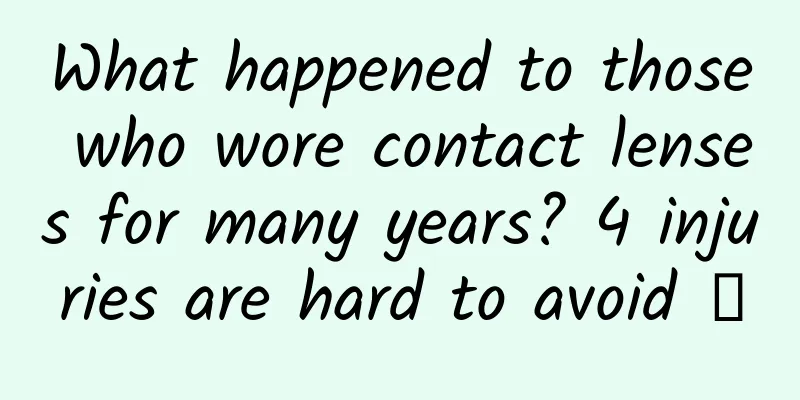What happened to those who wore contact lenses for many years? 4 injuries are hard to avoid →

|
Many people are familiar with contact lenses, and many girls like to wear them. They can get rid of the constraints of frame glasses and make the eyes look bright and beautiful. Compared to frame glasses, contact lenses are also very convenient to purchase and replace. They are easy to buy both online and offline, especially "beautified lenses", which can also change the "color" of your eyes. Contact lenses look good, but if they are not chosen and worn correctly, they may cause damage to our eyes or even blindness. For example, in some severe cases of infectious keratitis, corneal transplantation may be necessary to save vision, which is not an exaggeration. The scientific name of contact lenses is contact lenses, which are divided into soft contact lenses and hard contact lenses. The "contact lenses" we usually refer to are soft contact lenses . Don't underestimate these contact lenses. According to the provisions of China's "Medical Device Supervision and Management Regulations", "contact lenses" are classified as the highest level of Class III medical devices for management. Other Class III medical devices include implantable cardiac pacemakers, intraocular lenses, ultrasound tumor focusing knives, hemodialysis devices, implantable equipment, vascular stents, integrated anesthesia machines, dental implant materials, medical absorbable sutures, intravascular catheters, etc. It can be seen that contact lenses are medical devices with high risks, and special measures need to be taken to strictly control and manage them to ensure their safety and effectiveness. Although contact lenses are small, there are certain risks in using them, and they need to be purchased through formal channels and used correctly. Some people like to use contact lenses as a complete substitute for frame glasses and wear them continuously for a long time. So what problems will these people encounter? What kind of impact will contact lenses have on our eyes if they are not worn correctly? What happens if you wear contact lenses for a long time? 1 Ocular surface abnormalities Conjunctival adverse reactions The conjunctiva is a transparent, elastic and mobile tissue on the surface of the white of our eyeball. Adverse reactions to the conjunctiva mainly include non-infectious conjunctivitis, infectious conjunctivitis and allergic conjunctivitis. Symptoms include redness of the white of the eyeball, itching, foreign body sensation, increased secretions and other discomforts. The skin around the eye may also become congested, edematous or eczema. Non-infectious conjunctivitis is often related to incomplete lens cleaning and irritation of the eye caused by lens deposits. Infectious conjunctivitis is often related to lens stains, deformation, expired use, improper care, and neglect of personal hygiene. Allergic conjunctivitis is often caused by direct contact between lenses and care products that irritate the ocular surface, long-term mechanical friction, etc. Image source: Reference [9] Corneal adverse reactions The cornea is the completely transparent tissue on the surface of the "black eyeball" that we see. Corneal adverse reactions mainly include non-infectious corneal lesions and infectious keratitis. Symptoms may include white lesions on the cornea, decreased vision, severe eye pain, fear of light, tearing, fear of opening eyes, etc. These symptoms are often related to tight lenses, lens displacement, deposits on the lens surface, wearing lenses with low air permeability, chronic corneal hypoxia caused by long-term wearing of lenses, and changes in tear osmotic pressure. Wearing contact lenses with low air permeability overnight will aggravate anterior segment hypoxia and more easily induce adverse corneal reactions. For some people, new blood vessels will grow into the cornea . A normal cornea has no blood vessels, but long-term wearing of contact lenses leads to chronic hypoxia of the ocular surface, causing new blood vessels to grow from the "white eyeball" into the "black eyeball", and these blood vessels are difficult to disappear even after stopping wearing contact lenses. Long-term contact lens wear will cause the cornea to become less transparent , making the eyes look less bright and the boundary between the white and black parts of the eye less clear. Many people who wear contact lenses for a long time feel that their eyes have become "dull". Studies have found that women who continue to wear soft contact lenses for 5 years will not experience any effect on corneal transparency, but continued wearing for more than 5 years will lead to a decrease in the transparency of the superficial peripheral cornea . Tear film abnormalities People who wear contact lenses for a long time are most likely to suffer from dry eyes, which manifests as dry eyes, foreign body sensation, burning sensation , etc. The main reasons are that wearing contact lenses affects the stability of tears, high water content soft lenses increase the osmotic pressure of tears, and lens deposits cause the wettability of lenses to decrease. Studies have shown that long-term (>3 years) wearing of corneal contact lenses can affect the morphology of the meibomian glands, causing glandular loss, which may be one of the important reasons for dry eyes in long-term contact lens wearers. Long-term use of video display terminals by contact lens wearers can lead to reduced blinking frequency, aggravated incomplete blinking and excessive tear evaporation. Low humidity and air pollution environments can affect the cleanliness and dryness of the contact lenses themselves, as well as the wearer's ocular surface and tear film status, thereby causing or aggravating dry eyes. 2 Visual abnormalities Most people with visual abnormalities often describe their symptoms as "uncomfortable after wearing for a long time", "tired after wearing for a long time", "more obvious at night", etc. These symptoms are mostly caused by improper selection and poor adaptation of contact lenses. In addition to the potential harm that contact lenses cause to our eyes, the wearing environment also has a certain impact on the safety of corneal contact lenses . For swimmers, sailors, lifeguards, surfing enthusiasts and other people who have close contact with water and have refractive errors, if they wear frame glasses, they may fall off at any time due to water pressure or strenuous exercise. Compared with frame glasses, contact lenses have better lens stability, low breakage rate, and no fogging in sports, which are deeply favored by water sports enthusiasts. However, there are reports in the literature that wearing contact lenses while swimming will increase the bacterial load on the contact lenses, making them more susceptible to bacterial keratitis and even Acanthamoeba keratitis. And the latest research shows that wearing contact lenses while in contact with any water source will increase the risk of infection . Therefore, contact lens wearers who may come into contact with water sources should wear disposable daily disposable contact lenses, or strictly disinfect and sterilize them after daily wear, and regularly replace lenses and care solutions to achieve safe and effective wearing. Typical annular infiltrate of Acanthamoeba keratitis Image source: Keratology 2nd edition Late stage of Acanthamoeba keratitis Image source: Keratology 2nd edition How to choose the right contact lenses? When choosing contact lenses, focus on two indicators: 1. Oxygen permeability (Dk/t) is a measure of a specific lens, not a lens material. Dk/t refers to the oxygen permeability (Dk) of the material normalized by the lens thickness (t). The higher the Dk/t value, the better the oxygen permeability of the lens. Traditional hydrogel materials (HEMA) have poor oxygen permeability, and those that exceed 20 are considered good. According to the requirements of the International Contact Lens Educators Association, the Dk/t value of daily disposable lenses must be greater than 24. The Dk/t of the current mainstream silicone hydrogel contact lenses is above 100. 2. Material: The current mainstream material is silicone hydrogel, which is recommended as the first choice. Since soft contact lenses can absorb chemicals and deposit substances on their surface, they need to be replaced according to the wearer and lens type. 1. Quarterly lenses : Replaced every 3 months, usually customized, expensive, not suitable for frequent replacement. Patients need to follow the recommended cleaning and disinfection process to keep the lenses clean and the cornea healthy. Quarterly lenses usually come in packs of 4 and can be worn for one year. 2. Monthly disposable : Many brands have this type, which also requires daily cleaning and disinfection. The replacement cycle is easy to remember and the price is more reasonable. 3. Weekly disposable lenses : Similar to monthly disposable lenses, they need to be cleaned and disinfected daily. However, studies have found that most patients who use these lenses do not follow the recommended replacement cycle. 4. Daily disposable : more common, becoming the most commonly used soft lens. Since it is discarded after daily use, it does not need to be disinfected. Advantages include: the eyes will not come into contact with disinfectant, new lenses are worn every day, and there is no need for storage boxes, maintenance solutions, and nighttime disinfection. The risk of corneal infiltration when wearing daily disposable lenses is also lower than that of monthly or 1-2 week disposable lenses. Therefore, if there are no special circumstances or the degree requires special customization , it is recommended to choose daily disposable products to reduce the risk of use and care. Because of the risk of eye infection and corneal ulcers, which can cause blindness, the U.S. Food and Drug Administration (FDA) has issued recommendations and guidelines for the safe use of contact lenses and related care products. These recommendations are as follows: Replace contact lens storage box every 3 to 6 months. Wash your hands every time you handle your contact lenses to reduce the possibility of infection. If you experience redness, irritation, or changes in vision, remove your lenses immediately. If symptoms do not improve, seek medical attention. Always follow your eye doctor's orders and follow all label instructions for the proper use of contact lenses and related care products. Use contact lens products and solutions recommended by ophthalmologists. Do not use expired contact lens solution. Follow your eye care professional's instructions for flushing contact lenses. Follow the label instructions provided with your contact lens care product to properly clean and disinfect your contact lenses. Do not mix fresh care solution with the remaining care solution (old or used) in the lens storage box. All used care solution should be discarded and never reused. Never use unsterile water (distilled, tap, or homemade saline solution). There have been reports of Acanthamoeba keratitis following contact lens contact with water, a corneal infection that is difficult to treat and cure. Do not put your contact lenses in your mouth to moisten them; saliva is not a sterile solution. Clean, rinse, and dry the lens storage case each time you remove your contact lenses. You may want to turn the lens storage case over while drying to allow excess solution to drain from the case. Contact lens storage cases can be a source of bacterial growth. Do not pour the solution into smaller travel-sized containers. This can compromise the sterility of the solution and lead to eye infection. Pouring the solution into smaller containers may also cause the user to accidentally use a solution that is not intended for use in the eye. Finally, I would like to emphasize: Don't forget that "contact lenses" are managed as Class III medical devices, but the contact lenses on the market are mixed, good and bad. Don't buy "three-no" contact lenses at "street stalls" or "night markets" for cheap, not only will you not save much money, but it will also bring huge risks to your eye health. When choosing contact lenses, please be careful and choose a regular medical institution or online platform to buy them. Before buying, check whether the packaging label is clear and standardized, and whether there is a clear medical device registration certificate number. For example, if the national medical device is registered in 20183221999, the national medical device registration "Jin" indicates that it is a medical device produced in other countries. The national medical device registration "Xu" indicates that it is a medical device produced in Hong Kong, Macao, and Taiwan. The national medical device registration "Zhun" indicates that it is a medical device produced in the mainland. "3" means that the product management category belongs to Class 3 medical devices. Tips As an ophthalmologist, I often encounter patients who come to the emergency room and complain that they cannot remove their contact lenses. A considerable number of these patients' contact lenses have been removed or fallen out, but they cannot find them and mistakenly think that they are still in their eyes. However, they try to take them out repeatedly but find nothing. The conjunctiva is prone to swelling after repeated stimulation. There are even some "heartless" patients who mistakenly tear the edematous conjunctiva as a "contact lens" and forcibly tear it apart. So the question is, how to determine whether the contact lenses should be removed? Answer: If a myopic patient feels that he can see things very clearly, it means that the contact lenses are still there. If he feels that he can't see things clearly, it is likely that the contact lenses have been taken out or fallen out. If you are unsure whether the contact lens has been removed or find that it is incomplete, seek help from an ophthalmologist as soon as possible. Do not pull or yank blindly to avoid causing unnecessary damage to the ocular surface. References [1] Contact Lens Safety Monitoring and Visual Health Professional Committee of China Health Management Association. Expert consensus on the diagnosis and treatment of contact lens-related dry eye in China (2024)[J]. Chinese Journal of Ophthalmology, 2024, 60:(02): 120-126. [2] Contact Lens Safety Monitoring and Visual Health Professional Committee of China Health Management Association. Expert consensus on diagnosis and treatment of adverse reactions to contact lenses in China (2021) [J]. Chinese Journal of Ophthalmology, 2021, 57:(08): 573-579. [3] Dong Yahui, Hou Jie, Zhang Jing, et al. Effects of long-term soft contact lens wear on corneal transparency in myopic patients[J]. Chinese Journal of Experimental Ophthalmology, 2023, 41:(04): 344-350. [4] Zhou Ying, Tan Gang, Zhao Zhichun, et al. Effect of wearing environment on the safety of contact lens wearing[J]. Chinese Journal of Optometry and Visual Science, 2018, 20:(8): 509-512. [5] Tang Yun, Wu Yuan, Rong Bei, et al. A preliminary study on the effect of wearing corneal contact lenses on meibomian glands[J]. Chinese Journal of Ophthalmology, 2016, 52:(8): 604-609. [6] UpToDate Keywords: Contact lenses Overview [7] Xie Lixin, Shi Weiyun. Corneal Disease[M]. 2nd edition. Beijing: People's Medical Publishing House, 2023:282-287. [8]https://journal.medizzy.com/can-contact-lenses-cause-blindness/ [9]https://www.10faq.com/health/conjunctivitis-symptoms/5/ Planning and production Author: Liu Gang, deputy chief physician of ophthalmology, Qilu Hospital, Shandong University, Qingdao Branch Review丨Jin Xiuming, Deputy Director of the Ophthalmology Center, Zhejiang University Second Hospital Planning丨Wang Mengru Editor: Wang Mengru Proofread by Xu Lailinlin |
<<: This kind of fossil is called the "time pointer" of the rock layer
>>: The latest news is that our close relatives are already eating noodles with chopsticks!
Recommend
Guangdiantong information flow advertising delivery model
Tencent has two major information flow platforms,...
Who invented the concept of virtual age?
At the end of every year, the firecrackers in the...
Private tips on how to place game information streams, told to you for free!
Before reading this article, we need to have a co...
SEO plan planning, how do SEO practitioners formulate plans?
Some time ago, a friend asked me on WeChat, if I ...
Where is the antidote for short videos?
Today, more and more giants have joined the short...
The keywords in Baidu's bidding promotion account have high display, low clicks and low consumption. What should I do? Can I delete them?
1. Positioning center. Be sure to locate the cent...
Douyin Promotion and Operation丨How to write a Douyin title that gets over 10,000 likes?
When it comes to new media, the first thing that ...
What does the Douyin live broadcast field control operation do? Introduction to the responsibilities of Douyin live broadcast control
The number of viewers of Douyin live broadcasts i...
6 high-quality details of 100,000+ soft article titles
For soft articles, the first impression is the ti...
Chicken soup is poisonous: Don’t let other people’s experience kill you when operating a public platform
With 549 million monthly active WeChat users and ...
[Astrology and the True Self] A must-have tool for astrology beginners and practicing astrologers, the most solid and detailed astrology guide
[Astrology and the True Self] A must-have tool fo...
There are 6 ways to create a brand story that will spark discussion
New Balance tells a story about Li Zongsheng'...
This pre-meal step is possible, but not necessary
When dining out, many people are used to boiling ...
Are nematodes disgusting? You should thank them for your sushi
In the once popular movie "Invasion of the I...
Telecom broadband package price list 2021 (Telecom latest tariff flow package list)
The 2021 China Telecom broadband package price li...









